Principles of Landing Sales
Marketing landing is a key element of an advertising campaign that affects the conversion of users into a client (customer). If the goal of an ad is to attract the user's attention, then the task of effective landing is to keep the user on the page and convince them to perform the target action. There are many recommendations on how to create a marketing landing page, but there is no universal recipe. Depending on the product advertised, there are different approaches for creating a sales landing page.
In general, the landing page consists of the following elements:
1. Ad design and landing design should match.
If a user clicks on an ad, he expects to see some continuation of the ad he is interested in. Consequently, the color scheme, the style of presentation of the text, and the overall style should be the same, if we talk about banner or teaser advertising. On the other hand, too colored bright landing pages do not bring a good envelope. We can say that the rule “the simpler, the better” is valid for landings. The smaller the large font, the images, the intriguing headlines, but the more specific information about what the product is and the benefits the user will receive, the more effective the landing page will be. Red is also not recommended for use.
')
To link a “screaming” ad with a more or less restrained landing, you can use the same upper part of the teaser and landing page. This bundle is effective for teaser ads.
2. The heading and subtitle of the landing page contain information about what is a product, service, presented on the page.
Returning to the previous paragraph that the design of the ad and the landing should coincide, the title and subtitle, in turn, should logically continue the headline of the advertisement or repeat the main message when it comes to a rally or promotion.
Heading / subheading options:


3. Picture
The image (s) on the landing page has a tremendous effect and is the main element of the selling landing page.
What images should I use?
The advertising option for a particular product is the easiest. In this case, it is enough to place a photo of the product or person who uses this product.
A good option to show the effect of the application of the product - photo before and photo after.
To advertise an intangible object, there are several approaches:
4. Description
The task of the description is to explain to the user what he will receive when purchasing a product.
The descriptions can be:
Arguments are a direct description of the benefits that the user will receive when purchasing a product, and not a listing of product characteristics or company achievements.
Answers to questions should dispel user doubts. These can be real reviews and comments from industry experts.
With regard to information that increases trust, then loyalty to users is promoted by certification marks, contact details, and company information. What information to place on the landing page is curled directly from the target action.
For example, the user must leave contact information for feedback. In this case, the landing page should contain information about the company, contact details and the cost of the incoming call.
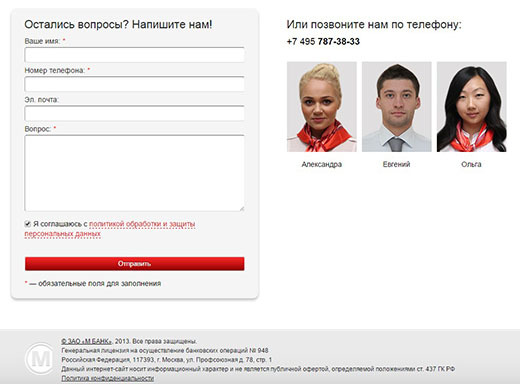
Another example is licensed products, slimming preparations, etc. In this case, it is appropriate to post information that the product is certified and approved by the Ministry of Health.
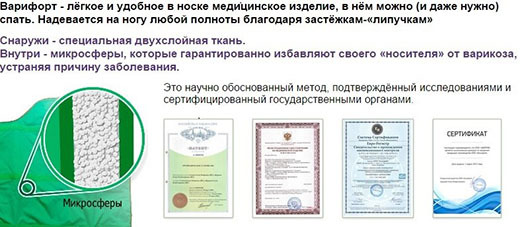
If an advertisement concerns an info-product, for example, an e-book or a course, then it is advisable to place detailed information about the authors.
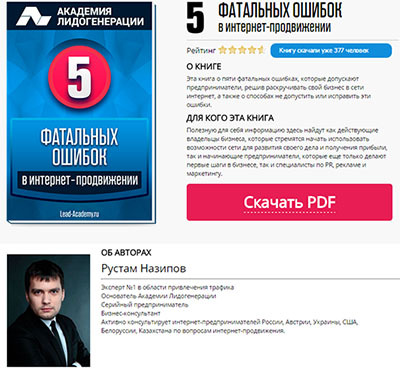
For advertising products - information on delivery, warranty, contact phone number.
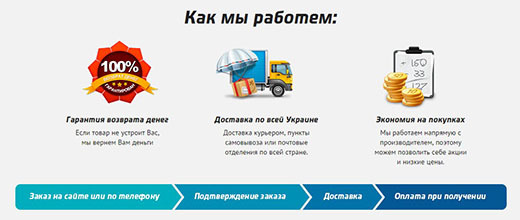
Information about promotions and discounts pushes the user to commit the target action. The limited offer, the last day of the discount action, etc., stimulates the user to perform the target action immediately.

5. The call to action should be as accurate and clear as possible.
A call to action is the last argument. If the user has already moved to the landing page, then the main task is to prevent him from leaving the page. The title, image and description, providing information in a logical sequence, lead the user to the "Call to action" button.
Always start from the end. Formulate a target action and remove unnecessary information that is not relevant to the target action. Excess information on the landing page only reduces conversion.
Where should the call to action button be located?
Ideally, up to the “fold line” so that the user does not have to scroll down. If the landing page contains a lot of information and the CTA does not fit at the top of the page, then you can place the CTA after each block of information or make a dynamic CTA that will appear when the user reads approximately ⅔ of the text.
The execution of the target action should be as simple as possible for the user. The ideal option is 1 click, for example, click to call, click to download, click to request a quote. If the user needs to fill in the registration fields, then the number of completed fields should be minimized. Registration with an account of social networks greatly simplifies the life of the user, and accordingly increases the conversion.
The text on the call to action button deserves special attention. The correct text on average increases conversion by 30%.
Examples of testing different variants of the STA .


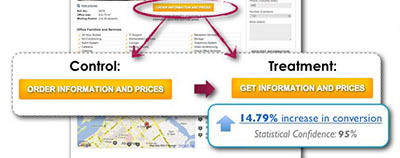
In conclusion, it should be added that only through split testing can high conversion be achieved. By consistently testing each element, you can determine which combination of title, subtitle, descriptions, images, and CTA makes landing page marketing.
Do not forget to analyze and correctly identify the problems of your target audience. If there is an opportunity to interview users who have left their contact details, but have not made a purchase, be sure to take advantage of this opportunity, perhaps the reason is that the support phone is not striking.
In general, the landing page consists of the following elements:
- Header / Handle
- Picture
- Description
- Call to action
- Enhance call-to-action (promotions, coupons, discounts, limited offer)
Rules for creating a landing page
1. Ad design and landing design should match.
If a user clicks on an ad, he expects to see some continuation of the ad he is interested in. Consequently, the color scheme, the style of presentation of the text, and the overall style should be the same, if we talk about banner or teaser advertising. On the other hand, too colored bright landing pages do not bring a good envelope. We can say that the rule “the simpler, the better” is valid for landings. The smaller the large font, the images, the intriguing headlines, but the more specific information about what the product is and the benefits the user will receive, the more effective the landing page will be. Red is also not recommended for use.
')
To link a “screaming” ad with a more or less restrained landing, you can use the same upper part of the teaser and landing page. This bundle is effective for teaser ads.
2. The heading and subtitle of the landing page contain information about what is a product, service, presented on the page.
Returning to the previous paragraph that the design of the ad and the landing should coincide, the title and subtitle, in turn, should logically continue the headline of the advertisement or repeat the main message when it comes to a rally or promotion.
Heading / subheading options:
- problem / issue that concerns the target audience;
- specific benefits with numbers (lose 8 kg, save 50%, buy cheaper, etc.);
- the name of the proposed product;
- unique selling proposition.


3. Picture
The image (s) on the landing page has a tremendous effect and is the main element of the selling landing page.
What images should I use?
The advertising option for a particular product is the easiest. In this case, it is enough to place a photo of the product or person who uses this product.
A good option to show the effect of the application of the product - photo before and photo after.
To advertise an intangible object, there are several approaches:
- The image evokes associations with the benefit / benefit that the product will bring, for example, insurance services - security, banking services - financial stability, educational services - a successful career, etc.
- Photos of smiling people. As practice shows, photos of smiling people, positive emotions allow the user to better perceive information and contribute to the commission of the target action.
4. Description
The task of the description is to explain to the user what he will receive when purchasing a product.
The descriptions can be:
- arguments;
- answers on questions;
- trust information;
- promotions, discounts, etc.
Arguments are a direct description of the benefits that the user will receive when purchasing a product, and not a listing of product characteristics or company achievements.
Answers to questions should dispel user doubts. These can be real reviews and comments from industry experts.
With regard to information that increases trust, then loyalty to users is promoted by certification marks, contact details, and company information. What information to place on the landing page is curled directly from the target action.
For example, the user must leave contact information for feedback. In this case, the landing page should contain information about the company, contact details and the cost of the incoming call.

Another example is licensed products, slimming preparations, etc. In this case, it is appropriate to post information that the product is certified and approved by the Ministry of Health.

If an advertisement concerns an info-product, for example, an e-book or a course, then it is advisable to place detailed information about the authors.

For advertising products - information on delivery, warranty, contact phone number.

Information about promotions and discounts pushes the user to commit the target action. The limited offer, the last day of the discount action, etc., stimulates the user to perform the target action immediately.

5. The call to action should be as accurate and clear as possible.
A call to action is the last argument. If the user has already moved to the landing page, then the main task is to prevent him from leaving the page. The title, image and description, providing information in a logical sequence, lead the user to the "Call to action" button.
Always start from the end. Formulate a target action and remove unnecessary information that is not relevant to the target action. Excess information on the landing page only reduces conversion.
Where should the call to action button be located?
Ideally, up to the “fold line” so that the user does not have to scroll down. If the landing page contains a lot of information and the CTA does not fit at the top of the page, then you can place the CTA after each block of information or make a dynamic CTA that will appear when the user reads approximately ⅔ of the text.
The execution of the target action should be as simple as possible for the user. The ideal option is 1 click, for example, click to call, click to download, click to request a quote. If the user needs to fill in the registration fields, then the number of completed fields should be minimized. Registration with an account of social networks greatly simplifies the life of the user, and accordingly increases the conversion.
The text on the call to action button deserves special attention. The correct text on average increases conversion by 30%.
Examples of testing different variants of the STA .



In conclusion, it should be added that only through split testing can high conversion be achieved. By consistently testing each element, you can determine which combination of title, subtitle, descriptions, images, and CTA makes landing page marketing.
Do not forget to analyze and correctly identify the problems of your target audience. If there is an opportunity to interview users who have left their contact details, but have not made a purchase, be sure to take advantage of this opportunity, perhaps the reason is that the support phone is not striking.
Source: https://habr.com/ru/post/283756/
All Articles